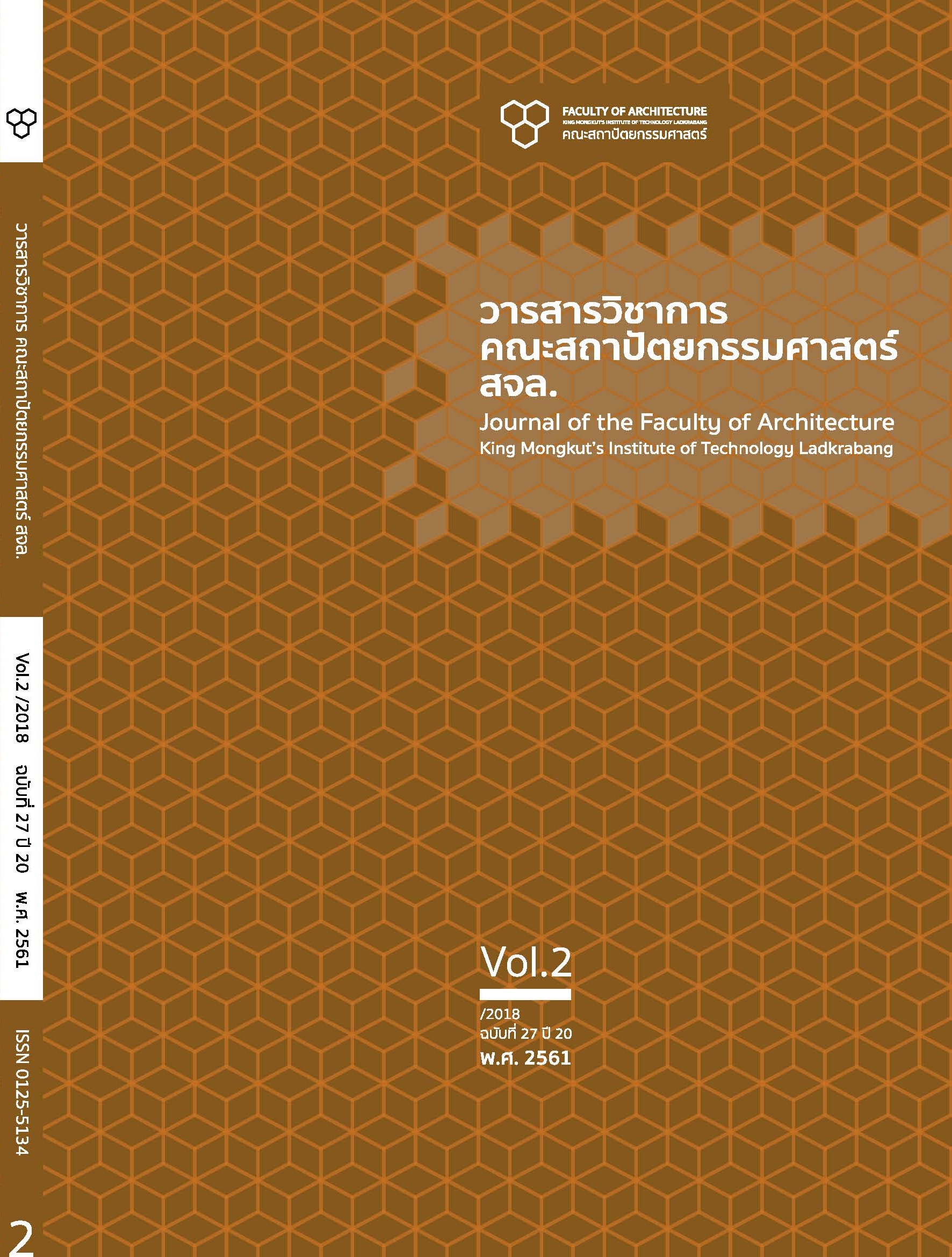การออกแบบโฆษณาส่งเสริมสังคมสำหรับปัญหาสังคมที่มีอิทธิพลต่อมิลเลนเนียลเจนเนอเรชั่น Public Service Advertising Design for the Social Problems that Influence Millennial Generation
Main Article Content
Abstract
บทคัดย่อ
งานวิจัยนี้มีวัตถุประสงค์เพื่อศึกษาการออกแบบโฆษณาส่งเสริมสังคมสำหรับปัญหาสังคมที่มีอิทธิพลต่อมิลเลนเนียลเจนเนอเรชั่นโดยมีวัตถุประสงค์ ดังนี้ 1) เพื่อค้นหาปัญหาสังคมที่มีอิทธิพลต่อมิลเลนเนียลเจอเนอเรชั่น 2) เพื่อค้นหาหลักการออกแบบโฆษณาส่งเสริมสังคมที่มีความเหมาะสมกับมิลเลนเนียลเจนเนอเรชั่นประกอบด้วยกรอบทฤษฎีการกาหนดวัตถุประสงค์ (Purpose of Awareness) กลยุทธ์การสื่อสาร (Communication Strategies) การใช้จุดจับใจ (Advertising Appeal) และการนำเสนอความคิดสร้างสรรค์ (Creative Execution) และเก็บข้อมูลด้วยเครื่องมือการวิจัยประเภทแบบสอบถามออนไลน์ (Online Questionnaire) จากกลุ่มเป้าหมายที่มีอายุระหว่าง 18-38 ปี จำนวน 239 คน เพื่อจัดลำดับความสนใจในปัญหาสังคม และการวิจัยแบบสนทนากลุ่ม (Focus Group) 7 กลุ่มๆ ละ 5 คน เพื่อคัดเลือก ผลงานโฆษณาที่สามารถสร้างการรับรู้และการตอบสนองด้านอารมณ์และพฤติกรรม จากผลงานโฆษณาช่วงปี ค.ศ. 2011 ถึงค.ศ. 2017 ที่ได้รับรางวัลระดับนานาชาติจำนวน 328 ชิ้นงาน และทำการวิเคราะห์หาองค์ประกอบทางการออกแบบ โฆษณา จากผู้เชี่ยวชาญและนักวิชาการด้านโฆษณาที่มีประสบการณ์ไม่ต่ากว่า 7 ปี จำนวน 15 ท่าน โดยให้ผู้เชี่ยวชาญทำการเลือกองค์ประกอบต่างๆ ในการออกแบบโฆษณาส่งเสริมสังคม ผลวิจัยพบว่า 1) ปัญหาสังคมที่มิลเลนเนียลเจนเนอเรชั่นมีความสนใจ 14 ประเด็นปัญหา อาทิ ปัญหาการศึกษา ปัญหาอาชญากรรมและความรุนแรง ปัญหาความเจ็บป่วยทางจิต 2) แนวทางการออกแบบโฆษณาส่งเสริมสังคมสำหรับมิลเลนเนียลเจนเนอเรชั่นการกำหนดวัตถุประสงค์การโฆษณา จานวน 3 วัตถุประสงค์ กลยุทธ์การสื่อสาร จำนวน 14 กลยุทธ์ อาทิกลยุทธ์ การทำให้มี ความรู้สึกไม่ดี ถ้าตนไม่ได้ปฏิบัติ ตามกลยุทธ์การใช้ความเชี่ยวชาญของผู้ส่งสารโน้มน้าวไปในทางลบ กลยุทธ์ด้านศีลธรรม การใช้จุดจับใจ จำนวน 23 รูปแบบ อาทิ ด้านความรู้สึกผิด ด้านความกลัว ด้านความเห็นอกเห็นใจ การนำเสนอความคิดสร้างสรรค์ จำนวน 19 รูปแบบ อาทิ การใช้วิธีเปรียบเทียบแบบอุปมาอุปไมย การเปลี่ยนมุมมอง และการใช้สัญลักษณ์และเครื่องหมาย เป็นต้น
คำสำคัญ: การออกแบบโฆษณา ส่งเสริมสังคม ปัญหาสังคม มิลเลนเนียลเจนเนอเรชั่น
Abstract
This research aims to study the design of public service advertisements related to social problems that affect the millennial generation. More specifically, it aims to determine what are social problems having most effect to the millennial generation and to discover which concepts of public service advertising design are suitable for them. The theoretical framework for public service advertising design consists of 1) purpose of awareness, 2) communication strategies, 3) advertising appeal, and 4) creative execution. In order to rank the social problems based on participants’ interest, data were collected from 239 millennials generation aged from 18 to 38 years old using online questionnaires as the research instrument, and they were brought in the focus group discussions. In the discussions, seven groups, comprising five members each, selected public service advertisements from a total of 328 advertisements, which can represent people’s emotional perception and reflect people behavior, that were internationally awarded between 2011 to 2017. The selected advertisements were then analyzed by 15 experts and academic faculties, who have at least seven years’ experience in advertisement design by identifying the elements of public service advertising design for each social problem. This analysis was based upon the theoretical framework of four-element advertising design. The study found that the millennial generation was most interested in 14 problems, such as 1) problems of education, 2) crime and violence, and 3) mental Illness. There are three objectives for the advertising, adopting 14 communication strategies, such as bad felling, expertise, negative, moral, and using 23 forms of advertising appeal, such as guilt appeal, fear appeal, sympathy appeal and 19 forms of creative execution such as, metaphor and analogy, a change of perspective, and symbols and signs.
Keywords: Advertising Design, Public Service, Social Problems, Millennial Generation
Article Details
This work is licensed under a Creative Commons Attribution-NonCommercial-ShareAlike 4.0 International License.
Copyright Transfer Statement
The copyright of this article is transferred to Journal of The Faculty of Architecture King Mongkut's Institute of Technology Ladkrabang with effect if and when the article is accepted for publication. The copyright transfer covers the exclusive right to reproduce and distribute the article, including reprints, translations, photographic reproductions, electronic form (offline, online) or any other reproductions of similar nature.
The author warrants that this contribution is original and that he/she has full power to make this grant. The author signs for and accepts responsibility for releasing this material on behalf of any and all co-authors.
References
นฤมล นิราทร. (2559). การเปลี่ยนแปลงทางสังคมและปัญหาสังคม. กรุงเทพฯ: สานักพิมพ์มหาวิทยาลัยธรรมศาสตร์.
สถาพร หาญพานิช. (2546). การนำเสนอความคิดสร้างสรรค์ในสิ่งพิมพ์โฆษณา. (วิทยานิพนธ์ปริญญาศิลปะศาสตรมหาบัณฑิต, มหาวิทยาลัยศิลปากร).
สิปปณัฐ สาเริง. (2545). กลยุทธ์สาร และ การตอบสนองของผู้บริโภคต่อภาพยนตร์โฆษณาส่งเสริมสังคม.(วิทยานิพนธ์ปริญญานิเทศศาสตรมหาบัณฑิต, จุฬาลงกรณ์มหาวิทยาลัย).
สุจติรา รัตนกรกช. (2533). การวิเคราะห์ภาพยนตร์โฆษณาส่งเสริมสังคม ตั้งแต่ พ.ศ. 2519-2531. (วิทยานิพนธ์ปริญญามหาบัณฑิต), จุฬาลงกรณ์มหาวิทยลัย, กรุงเทพฯ.
อารีย์ จงเกษมสุข. (2541). การรับรู้และทัศนคติที่มีต่อโฆษณาส่งเสริมสังคมที่ใช้ความกลัวเป็นสิ่งจูงใจ. (วิทยานิพนธ์ปริญญานิเทศศาสตรมหาบัณฑิต, จุฬาลงกรณ์มหาวิทยาลัย).
Fromm, J. and Garton, C (2013). Marketing to Millennials: Reach the Largest and Most Influential Generation of Consumers Ever. United States of America: Barkley, Inc.
Halley, A. (2014) . The Millennial Generation Rules. Retrieved from https://www.slideshare.net/AndyHalleyWright/millennials-knowledge-module-2014
Henstra, D. and A. McGowan, R. (2016). Millennials and Public Service: An Exploratory Analysis of Graduate Student Career Motivations and Expectations. Public Administration Quarterly. 40(3), 78-104.
Howe, N. and Strauss, W. (2000). Millennials Rising: The Next Great Generation. United States of America: Vintage.
Kotler, P. and Zaltman, G. (1971) . Social Marketing: An Approach to Planned Social Change. Journal of Marketing. 35(3), 3-12.
Ng, E. S., Gossett, C. W., & Winter, R. (2016). Millennials and Public Service Renewal: Introduction on Millennials and Public Service Motivation (PSM). Public Administration Quarterly. 40(3), 412-428.
Stein, J. (2013, 06 August 2017). Millennials: The Me Me Me Generation. Retrieved from http://time.com/247/millennials-the-me-me-me-generation/.
Sweeney, R. (2006). Millennial behaviors and demographics. Newark: New Jersey Institute of Technology. 12(3), 10.


